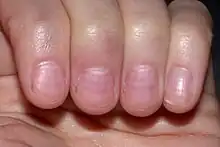| Muehrcke's lines | |
|---|---|
| Other names | Apparent leukonychia striata |
 | |
Muehrcke's nails or Muehrcke's lines (apparent leukonychia striata) are changes in the fingernail that may be a sign of an underlying medical condition. The term refers to a set of one or more pale transverse bands extending all the way across the nail, parallel to the lunula. In contrast to Beau's lines, they are not grooved (no 3-dimensional deformity), and in contrast to Mees' lines, the thumb is usually not involved.[1][2]
Muehrcke's lines are a strong indicator of hypoalbuminemia, which can result from a variety of different causes.[3][4]
The lines are actually in the vascular bed underneath the nail plate. As such, they do not move with nail growth, and disappear when pressure is applied to the nail (blanching the underlying nail bed): this distinguishes them from "true leukonychia striata" such as Mees' lines.[1] As in Terry's and half-and-half nails, the pattern is thought to be formed by bands of localized edema exerting pressure on the surrounding capillaries.[3][5]
Physiology
The appearance of Muehrcke's lines is associated specifically with marked hypoalbuminemia (serum albumin ≤ 2.2 g/dL) indicating decreased protein synthesis, which may occur during periods of metabolic stress (e.g. systemic infection, trauma, AIDS, chemotherapy), or in hypoalbuminemic states such as the nephrotic syndrome or dietary protein deficiency. They are also seen in patients with end-stage kidney disease on hemodialysis, Hodgkin's disease, pellagra, and sickle cell anaemia.[3][6][7][8][9]
The lines remain visible as long as protein intake is inadequate or synthesis is impaired, and they should disappear upon return to normal function.[3]
In extreme conditions, Muehrcke's lines may also arise from physical changes in peripheral circulation: one case study reported appearance of the lines in a healthy subject following ascent to 8,848 meters (29,029 ft) on Mount Everest.[10]
History
Muehrcke's lines were described by American physician Robert C. Muehrcke (1921–2003) in 1956. In a study published in BMJ, he examined patients with known chronic hypoalbuminemia and healthy volunteers, finding that the appearance of multiple transverse white lines was a highly specific marker for low serum albumin (no subject with the sign had SA over 2.2 g/dL), was associated with severity of the underlying condition, and disappeared upon successful treatment (corticosteroids in nephrotic syndrome) or direct infusion of HSA.[4]
See also
- Mees' lines – a similar appearance, except the lines are in the nail and move as the nail grows
- Half and half nails
- Terry's nails
- List of cutaneous conditions
References
- 1 2 Rapini, Ronald P.; Bolognia, Jean L.; Jorizzo, Joseph L. (2007). Dermatology: 2-Volume Set. St. Louis: Mosby. ISBN 978-1-4160-2999-1.
- ↑ Zaiac, Martin N.; Walker, Ashley (September 2013). "Nail abnormalities associated with systemic pathologies". Clinics in Dermatology. 31 (5): 627–649. doi:10.1016/j.clindermatol.2013.06.018. ISSN 1879-1131. PMID 24079592.
- 1 2 3 4 Singal, Archana; Arora, Rahul (2015). "Nail as a window of systemic diseases". Indian Dermatology Online Journal. 6 (2): 67–74. doi:10.4103/2229-5178.153002. ISSN 2229-5178. PMC 4375768. PMID 25821724.
- 1 2 MUEHRCKE RC (June 1956). "The finger-nails in chronic hypoalbuminaemia; a new physical sign". Br Med J. 1 (4979): 1327–8. doi:10.1136/bmj.1.4979.1327. PMC 1980060. PMID 13316143.
- ↑ Hinds, Ginette; Thomas, Valencia D. (January 2008). "Malignancy and cancer treatment-related hair and nail changes". Dermatologic Clinics. 26 (1): 59–68, viii. doi:10.1016/j.det.2007.08.003. ISSN 0733-8635. PMID 18023771.
- ↑ Freedberg, Irwin M.; et al., eds. (2003). Fitzpatrick's dermatology in general medicine (6th ed.). New York, NY: McGraw-Hill. p. 659. ISBN 978-0-07-138076-8.
- ↑ Bianchi L, Iraci S, Tomassoli M, Carrozzo AM, Nini G (1992). "Coexistence of apparent transverse leukonychia (Muehrcke's lines type) and longitudinal melanonychia after 5-fluorouracil/adriamycin/cyclophosphamide chemotherapy". Dermatology. 185 (3): 216–7. doi:10.1159/000247451. PMID 1446089.
- ↑ Chapman S, Cohen PR (April 1997). "Transverse leukonychia in patients receiving cancer chemotherapy". South. Med. J. 90 (4): 395–8. doi:10.1097/00007611-199704000-00006. PMID 9114829. S2CID 29031413.
- ↑ Morrison-Bryant M, Gradon JD (2007). "Muehrcke's Lines". N Engl J Med. 357 (9): 917. doi:10.1056/NEJMicm065055. PMID 17761595.
- ↑ Windsor, Jeremy S.; Hart, Nigel; Rodway, George W. (2009). "Muehrcke's Lines on Mt. Everest". High Altitude Medicine & Biology. 10 (1): 87–88. doi:10.1089/ham.2008.1079. ISSN 1557-8682. PMID 19278357.
Bibliography
- Fawcett, Robert S.; Sean Linford; Daniel L. Stulberg (March 15, 2004). "Nail Abnormalities: Clues to Systemic Disease". American Family Physician. 69 (6): 1417–24. PMID 15053406.
- James, William; Berger, Timothy; Elston, Dirk (2005). Andrews' Diseases of the Skin: Clinical Dermatology. (10th ed.). Saunders. ISBN 0-7216-2921-0.
- Muehrcke Lines of the Fingernails at eMedicine
- Muehrcke's Lines of the Fingernails on WebMD